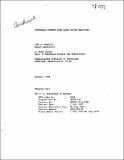Sinterable powders from laser driven reactions : annual report
Author(s)
Haggerty, John S.; Cannon, W. Roger.
DownloadMIT-EL-78-037-07505165.pdf (4.783Mb)
Metadata
Show full item recordAbstract
Novel methods for producing ideal powders for fabricating Si3N ceramic
parts have been investigated. The characteristics sought were principally
uniformly small diameter, equiaxed, high purity particles which are free of
agglomerates. Two laser processes were studied.
In the first, a CO2 laser source was used to heat the: reactant gases by
coupling directly to them. Silicon (Si) and Si3N4 powders have been synthesi-
zed directly from SiH4 and NH 3/SiH4 mixtures respectively. The spatially well-
defined reaction zone and the combination of the rapid heating rates with the
short times at reaction temperatures yielded very uniform and small diameter
particles. Si N powders were produced with particle diameters entirely with-
in the range o 00-200 A. The particles are equiaxed and nearly spherical.
The Si powders had the same general characteristics, but exhibited a slightly
larger range of diameters.
An analytical model gives an approximate description of the process. The
reaction proceeds as a thermal reaction at thresholds which agree with measured
optical absorptivities. The absorptivities are high, which will permit good
efficiencies to be achieved. We were not successful in inducing a multiphoton,
unimolecular reaction.
The second process uses selective heating to reduce the size of over-
sized particles or agglomerates as well as modifying the shape of high aspect
ratio particles. This process is based on the decreasing absorption efficiency
of a particle to light when its diameter is less than the wavelength cf the
incident light. Light induced comminution was demonstrated.
The power required for comminution is higher than was originally
anticipated, but it agrees with present analytical models. While the
process was demonstrated with a 150 watt CO2 laser, this power limitation
precluded an orderly investigation of process variables. It appears
that 750-1500 watts are required to operate continuously. These and
higher power C02 lasers are commercially available.
We have successfully demonstrated both processes for producing superior
Si ane Si3N4 powders. The results of the direct synthesis approach are
viewed as extremely important. Their uniform, small particle sizes make
them unique with respect to all other powders. While demonstrated with Si
and Si3N4 powders, the process appears applicable to other materials. More
work is required to determine the ultimate significance of the laser commi-
ntion process. It appears that the process will work as anticipated and
will induce the desired size and shape changes. It is apparent that it will
be an energy intensive process.
Description
Prepared for U.S. Department of Defense under Contract no. N00014-77-C-0581.
Date issued
1978-10Publisher
MIT Energy Laboratory
Other identifiers
07505165
Series/Report no.
MIT-EL78-037
Keywords
Powder metallurgy., Lasers, Silicon carbide., Silicon nitride
Collections
The following license files are associated with this item: